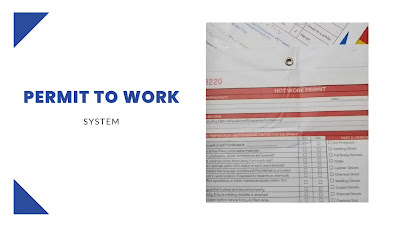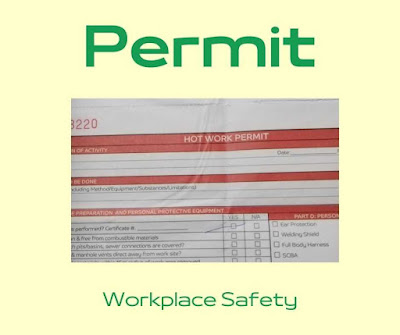Permit to work system HSE: A work permit is a formal written document used to work in restricted areas or high-risk activities. A work permit allows one to identify hazards and decide on control measures for the undertaken task. Permits to work are an essential part of safe system work for many maintenance, inspection or construction tasks. HSE
Permit-to-work system HSE allow work to begin only after safe procedures have been defined and provides a clear record that all foreseeable risks have been considered. A permit is required when maintenance/construction or inspection work can only be carried out if the work introduces new hazards. Some examples are entry into confined space, hot work, work at height etc.
This Measurement Technical Document refers to the work authorization systems necessary to control work such as maintenance activities in chemical plants and therefore prevent a major accident. The Work Permit is a systematic process used to authorize controlled work in unusual and potentially dangerous conditions. The process includes risk assessment, Job safety analysis, the establishment of safety protocols, communication and supervision to minimize environmental, health, safety and sustainability risks.
Industrial workplaces are full of hazards: welding spark spatters, corrosive chemicals, energized electrical conductors, confined spaces, loose valve fittings, the list is endless. And sometimes "small" incidents can turn into major accident hazards if not addressed properly.
Each of these circumstances carries critical risks to the health and safety of frontline workers, property, and the environment. For this reason, Permit to Work systems are a key element of a company's overall labour control strategy. Permit to Work is a systematic process designed to identify, communicate, mitigate, and control risk in hazardous areas, non-standard situations, and potentially dangerous conditions and prevent accidents.
Permit to work system is
The following aspects should be considered concerning work permit systems:
- Human factors;
- Management of work permit systems;
- low-skilled labour;
- Objectives of the work permit system;
- Types of work permit required;
- Content of work permits.
The following problems can contribute to a serious accident or hazard:
- Site safety management system failure;
- Failure to comply with the permit system to work in dangerous environments;
- Communication error when using a permit-to-work system.
- Contributing factors to be considered by an evaluator about the Work Permit System
Permit to work program
- Whether staff have been sufficiently informed, educated, trained, and supervised to minimize possible human inadequacy during the operation of the permit-to-work system;
- Whether the permit-to-work system includes sufficient safety information, maintenance instructions, correct PPE and equipment for use;
- Whether the work permit contains sufficient information on the type of work required (equipment disassembly, excavation, hot/cold work, confined space entry, waste removal, insulation);
- If sufficient supplies are available to meet the requirements of the work permit system;
- Whether the employees responsible for controlling the maintenance work are identified within the work permit system and whether the work has been duly authorized by a responsible person;
- Whether the work permit system is regularly managed, inspected and reviewed;
- Whether all work permits are kept on file;
Permit-to-work systems are essential to the safety of frontline workers. The process limits the impact of human error, ensures there are no surprise hazards on the job, and helps coordinate hazards throughout the workplace, such as erecting barriers to prevent welding sparks from flying near flammable chemicals.
Key elements of work permit systems
Regardless of the sector, a work permit system should include processes to:
- Determine dangerous areas
- Determine types of work considered dangerous
- Identify the scope of work and associated risks
- Appoint a person to authorize hazardous work
- Appoint work supervisors
- Designate people to perform the work safely
- Ensuring adequate training and instruction
- Communicate protocol to workers on-site or off-site daily
- Determine the allowable duration of hazardous tasks
- Establish a protocol for Simultaneous Operations (SIMOPS)
- Monitor and audit Work Permit systems
According to the Health and Safety Executive, an independent regulatory body based in the United Kingdom, work permit systems must also take into account the human factor, the objectives and management of the system, the level of qualification of the workforce, incompetence, and the types of work permits required.
How many types of permits to work
There are 6 types of permits commonly used in the Work Permit System:
- Hot Work Permit – The purpose of the Hot Work Permit is to ensure the proper initiation, review, approval and execution of the hot work activity. This type of permit is used for any work involving fire or ignition sources. May include welding, oxyacetylene cutting, and grinding.
- Cold Work Permit – The purpose of the Cold Work Permit is to control work activities that may not produce enough energy to ignite flammable atmospheres or combustible materials, but could result in injury. This permit is used as a category of coverage for various dangerous jobs, such as activities that involve cleaning with chemical substances, solvents, corrosives, resins, painting, manual lifting or scaffolding.
- Electrical Permit – This permit covers work that involves contact with energized electrical conductors. This may include the maintenance of telecommunications equipment or the installation of electrical conductors. The work may focus on live electrical equipment.
- Confined Space Permit – This permit helps control entry into confined spaces, such as trenches, tanks, or vessels. The purpose of the Confined Space Entry (CSE) Permit is to ensure: a) Proper preparation of confined spaces/vessels to be entered b) Secure entry of entrants, including rescue plans c) Confined Space Restoration
- Line break permit – The purpose of the line break permit is to ensure proper planning and precautions during work activities where the potential release of hazardous liquids or gases may occur. Releasing containment is a dangerous activity in the oil and gas industry, and fatal accidents continue to happen.
- Excavation Permit – The purpose of this permit is to ensure proper planning and design of excavation and trenching operations, including entry of personnel. It is used for drilling, digging trenches and digging in land or soil.
SABIC have 8 types of permits according to SHEMs 8.10
Health and safety-related topics:


.jpg)

